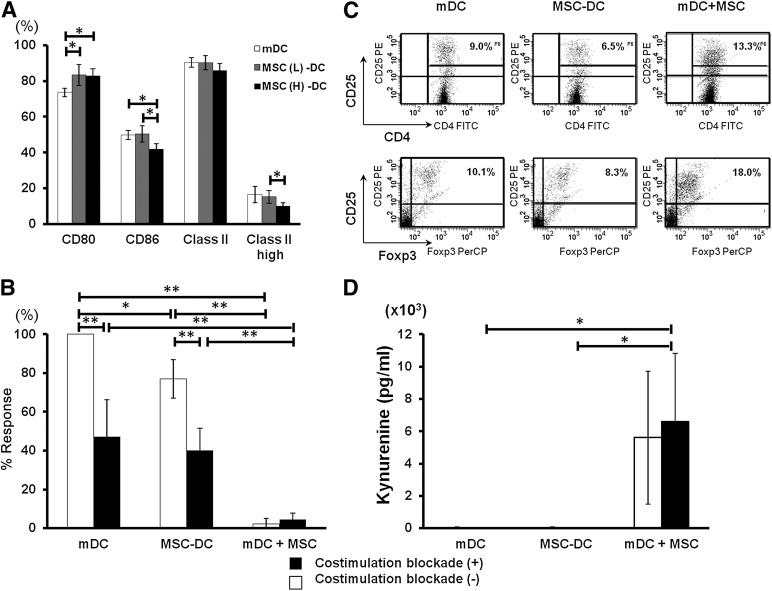Figure 6.
Suppression of dendritic cell (DC) maturation and alloreactive T cell proliferation or Foxp3 T cell induction by MSCs in vitro. (A): After a 24-hour stimulation with lipopolysaccharide, bone marrow-DCs with or without MSCs were isolated using anti-CD11c+ microbeads, and their surface markers were analyzed by fluorescence-activated cell sorting (FACS). The results are representative of four independent experiments. The percentage of CD11c+ cells expressing high levels of major histocompatibility complex class II decreased significantly when the amount of MSCs increased in the coculture. ∗, p < .05. (B): C57BL/6 CD4+ T cells (1 × 105) were cocultured with syngeneic DCs (2 × 104) and allogeneic Balb/c pan T cells (2 × 105) in the presence (black bar) or absence (white bar) of costimulation blockade for 4 days. The results are expressed as the mean cpm of relative increase after which syngeneic response was subtracted from and shown as mean ± SD of six independent experiments. ∗, p < .05; ∗∗, p < .01. (C): C57BL/6 CD4+ T cells (2 × 106) were cocultured with syngeneic DCs (4 × 105) and Balb/c pan T cells (4 × 106) in 12-well plates for 4 days. Nonadherent cells were harvested, followed by CD4+ isolation, and stained with CD4, CD25, and Foxp3 for FACS analysis. Results are one of the representatives of three independent experiments. (D): Supernatants in the presence (black bar) or absence (white bar) of costimulation blockade after 4 days of culture described in (C) were collected and the kynurenine concentrations were analyzed by enzyme-linked immunosorbent assay. Results are expressed as mean ± SD of three independent experiments. ∗, p < .05. Abbreviations: FITC, fluorescein isothiocyanate; mDC, mature dendritic cell; MSC, mesenchymal stromal cell; MSC (L)-DC, low dose (1 × 104; gray bar) mesenchymal stromal cell-treated dendritic cell; MSC (H)-DC, high dose (1 × 105; black bar) mesenchymal stromal cell-treated dendritic cell.

